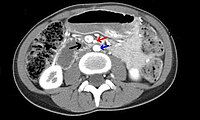
Photo from wikipedia
Intestinal malrotation (IM) is a very rare condition with an estimated incidence of far less than 1% [1, 2]. It is caused by an incomplete rotation around the superior mesenteric… Click to show full abstract
Intestinal malrotation (IM) is a very rare condition with an estimated incidence of far less than 1% [1, 2]. It is caused by an incomplete rotation around the superior mesenteric artery (SMA) that usually takes place between the fifth and tenth week of embryogenesis [2]. It is estimated that more than 90% of all cases are discovered during the 1 year of life. Thus, diagnosis in adult cases is a rarity [3, 4]. While most cases remain asymptomatic and may be found incidentally in radiological examinations or during elective surgery, some patients can present with severe symptoms such as volvulus or ileus requiring emergency surgery [1, 4]. As a consequence, case reports remain scarce in the literature. Especially in the emerging field of bariatric surgery, only a very limited number of cases have been reported so far, with the Roux-en-Y gastric bypass (RYGB) representing the dominating procedure [5]. Up to now, no case of one anastomosis gastric bypass (OAGB) has been published as far as we are aware of.
Journal Title: Obesity Surgery
Year Published: 2021
Link to full text (if available)
Share on Social Media: Sign Up to like & get
recommendations!